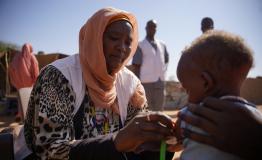

Sudan
The war in Sudan has had disastrous consequences for people’s health and wellbeing. Throughout 2024, Médecins Sans Frontières (MSF) delivered medical and humanitarian assistance across many of the country’s conflict-ravaged states.
The fighting between the Sudanese Armed Forces (SAF) and Rapid Support Forces (RSF) has caused the world’s largest displacement crisis, in which millions of people have been driven from their homes. Many have been subjected to ethnically motivated and sexual violence, and are facing malnutrition, as well as the loss of their homes and livelihoods. People’s suffering was compounded in the country’s eastern and central states by outbreaks of cholera, and spikes in malaria and dengue, fever during the year.
Our activities in 2024
Data and information for the 2024 International Activity Report

1,061,200
1,061,2
205,800
205,8
191,300
191,3
113,600
113,6

39,700
39,7
21,500
21,5
20,400
20,4
11,300
11,3

10,700
10,7
MSF in Sudan 2024
Map of the areas MSF worked in 2024


Cholera
Article
10 Dec 2024

War and conflict
MSF: 16% of war-wounded patients at south Khartoum hospital children
Article
23 Nov 2024

Conflict in Sudan
The Healing Hands of Sudan - Part two: Dispatch from South Sudan
Article
23 Oct 2024

Malnutrition
Sudan: Supply blockade forces MSF to stop care for 5,000 malnourished children in North Darfur
Article
11 Oct 2024

Refugee, migration and displacement
“Everything we want is to be able to live with dignity”
Article
17 Sep 2024

Cholera
MSF calls for quick response, unrestricted access as cholera poses latest peril in Sudan's war
Article
11 Sep 2024